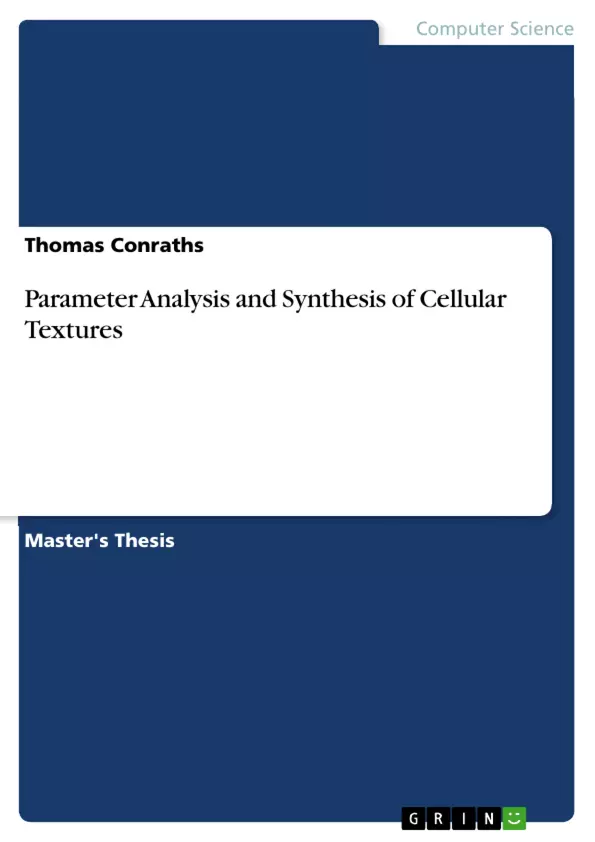The goal of this thesis is to provide a texture generation approach that works on cellular textures and enables structural modifications when generating a new output exemplar.
In the field of computer graphics, two-dimensional textures are an efficient tool to make a virtual scene richer in detail and therefore visually more appealing. Consequently, the perceived quality of a rendered image highly depends on the quality of the used textures.
Unfortunately, creating textures by hand is a time-consuming task, which in extreme cases can only be performed by professional artists. On the other hand, the use of real photographs often requires post-processing steps, e.g. to make them tileable so that there are no visual transitions between multiple texture copies covering a large surface.
Approaches exist that automatically create new texture variants with different sizes based on a given input sample. However, most of these methods focus on generating output textures that are as similar to the original input as possible, while not allowing for further modifications.
Table of Contents
- Introduction
- Related Work
- Texture Perception
- Stochastic Texture Synthesis
- Non-parametric Texture Synthesis
- Pixel-based Non-parametric Texture Synthesis
- Patch-based Synthesis
- Multi-Exemplar Synthesis
- Synthesis Output Manipulation
- Implications for this Thesis
- Fundamentals
- Textures
- Texture Types
- Texture Mapping
- Image Filters
- Image Pyramids
- Gaussian Pyramids
- Laplacian Pyramids
- Steerable Pyramids
- Worley-Noise
- Voronoi Diagrams
- Principal Component Analysis
- Gradient Descent
- Textures
- Methods and Implementation
- Cellular Textures
- Parameters
- Analysis
- Cell Segmentation
- Initial Parameter Generation
- Parameter Optimization
- Generation
- Cell Structure Generation
- Statistical Seed Placement
- Placement based on binary Input
- Storing Individual Cells
- Synthesis
- Filling Cells with Color
- Texture Refinement
- Multi-Exemplar Synthesis
- Evaluation
- Parameter Analysis
- Generated Results
- Tileable Input
- Parameter Preservation
- Parameter Modification
- Multi-Input Synthesis
- Limitations
- Conclusion and Future Work
- Conclusion
- Future Work
Objectives and Key Themes
This thesis aims to develop a novel approach for generating cellular textures with customizable output. By analyzing the underlying cellular structure of an input sample, the method facilitates the generation of textures tailored to specific use cases, offering an alternative to manual creation or using real photographs. The approach expands on traditional example-based synthesis methods by enabling structural modifications beyond simple output replication.
- Analysis of Cellular Textures
- Generation of Customized Cell Structures
- Synthesis with Structural Preservation and Modification
- Multi-Exemplar Texture Generation
- Evaluation of Parameter Analysis and Synthesis Results
Chapter Summaries
- Chapter 1: This chapter introduces the topic of texture synthesis and its importance in computer graphics. It highlights the need for efficient texture generation techniques to create visually appealing and realistic virtual environments.
- Chapter 2: This chapter reviews existing research in texture analysis and synthesis, focusing on different approaches for both stochastic and regular textures. It explores methods based on statistical models, non-parametric sampling, and multi-exemplar synthesis. The limitations of these methods in terms of structural modification are discussed.
- Chapter 3: This chapter presents fundamental concepts and techniques related to texture synthesis, including texture types, image filtering, image pyramids, and Voronoi diagrams. It also explains the principles of Principal Component Analysis and Gradient Descent optimization.
- Chapter 4: This chapter details the methods and implementation of the proposed texture generation approach. It describes the analysis of cellular textures, extraction of parameters, generation of new cell structures, and synthesis of the output image using mesh relaxation and pixel-based refinement.
- Chapter 5: This chapter evaluates the performance and limitations of the developed method. It analyzes the accuracy of parameter extraction, presents generated results for different use cases, and discusses the challenges and limitations of the approach.
Keywords
This thesis explores texture analysis, texture synthesis, image processing, cellular textures, Voronoi structure, optimization, and user-driven texture modification.
- Quote paper
- Thomas Conraths (Author), 2018, Parameter Analysis and Synthesis of Cellular Textures, Munich, GRIN Verlag, https://www.grin.com/document/1194367



